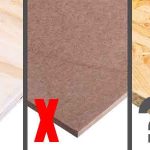The DIY Fix is reader supported. When you buy after clicking a link on our site, we may earn an affiliate commission.
The thought of having woodworm in your home can be a concern. Unless you’re an expert, spotting them can be difficult. Furthermore, if your home has damp problems, it can make it easier for woodworm to cause even more damage.
Perhaps you’ve noticed your wardrobe feels and looks damp. There could also be tell-tale signs of damage to the woodwork, that looks like woodworm. This could lead you to wonder if woodworm eats clothes.
The good news is that woodworm have very little interest in your clothing. They’d rather spend time eating their way through the wood in your wardrobe. This can cause a lot of damage to your furniture, much of which might not get noticed immediately. In the worst case scenario it could result in the need to replace your wardrobe. As well as woodworm spreading to other areas in your home.

When inspecting your clothing, you might spot dust on them. This is likely to be frass, which comes from the woodworm eating the timber. However, it doesn’t mean that they’ve targeted your clothing.
What Do Woodworm Eat?
You might be surprised to learn that there’s more than one type of woodworm. In fact, there are many different types of beetle larvae that could be causing damage to your timbers. These types of woodworm live in different habitats. In some cases, they also prefer different types of wood.
Common Furniture Beetle – When it comes to damage to timber, this beetle is one of the most common in British homes. It prefers softwood, European hardwood and sapwood and they can cause significant damage.
Deathwatch Beetle – This dark brown beetle has the potential to cause a lot of damage to timber. It attacks hardwoods like oak and is fond of well-rotted timber. It is also attracted to timber suffering from damp.
Powder Post Beetle – The Powder Post Beetle has a red colour. While it attacks wood, it is less likely to start in your home. It will usually enter timber before it is installed. You will often find them in timber that’s been stored and cured. Eventually, they’ll emerge from the final product. It will only attack the sapwood of hardwoods, such as oak.
House Longhorn Beetle – This type of beetle is larger in size than others. It is black with long antennae and is found in the Southwest of England. It attacks softwood and can cause serious damage to timber and properties.
Wood boring Weevils – This type of wood boring insect is small and black. It prefers softwoods and hardwoods suffering from decay. They are also well known for attacking damp skirting boards and joist ends.
What Type of Bugs Eat Clothes?
Maybe you’ve noticed small holes in clothing once you’ve removed it from your wardrobe? These holes could be caused by bugs that target clothing.
In the UK, there are two types of bugs that eat clothing. The most common are clothes moths and carpet beetles.
Clothes Moths – Clothes moths will target clothing, as well as other textiles in your home. The webbing clothes moth is the most common species and can cause plenty of damage.
As they prefer dark spaces, the wardrobe is the ideal home. Here they’ll lay eggs on your clothing and the larvae will hatch and eat your clothes as they grow.
They may also prefer textiles that are soiled or contain sweat. Clothes moths also prefer hidden areas, such as pockets and folds in textiles.
The Varied Carpet Beetle – This beetle is known in the UK due to the damage it can cause. They have gold and grey scales, making them quite easy to spot. In the warmer months, they spend time outdoors where they mate. They’ll then move inside to lay eggs in crevices and cracks.
Once the eggs hatch, the larvae eat quickly, this can cause lots of damage. They generally prefer woolen clothing as well as furs, As the name suggests, they are often found in carpets, but they also have a taste for clothing. Once inside, they can become very difficult to remove, as they can spread widely throughout the home.
Dampness and Mould Could Attract Infestations
It’s important to avoid dampness and mould where possible. Any signs of either should be managed quickly and efficiently.
Wooden wardrobes and drawers can be made from softwood, hardwood, or even engineered woods. All of these can be a target for woodworm.
A small amount of damp can cause further issues, making your furniture the perfect breeding ground for woodworm. Damp causes the wood to become softer, making it easier for woodworms to infest furniture and other timbers in your home.
If damp in your furniture becomes a problem, you should find the source and fix it. Not only could it result in an infestation, but damp and musty clothes could attract clothes eating bugs. In many cases condensation will be the causes. Using a good dehumidifier can work well to reduce moisture in the air.
Woodworm can take over furniture, but it’s important to remember, it can also enter other timber in the home. This can lead to structural damage, damage to other furniture and expensive repair bills.
Dampness and mould are not only bad for timber and wood in the home. It can also cause health issues, proving how important it is to tackle the problem as soon as possible.
Conclusion
Woodworm won’t attack your clothes, but they can infest your timber and furniture. Once you spot the clear signs of an infestation, you should deal with the problem.
It’s also important to keep dampness and mould at bay. If not, you might find your clothing under attack from a different set of clothes eating bugs.




